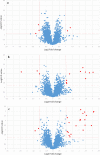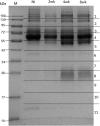Identification and profiling of Trichinella spiralis circulating antigens and proteins in sera of mice with trichinellosis
- PMID: 35271623
- PMCID: PMC8912135
- DOI: 10.1371/journal.pone.0265013
Identification and profiling of Trichinella spiralis circulating antigens and proteins in sera of mice with trichinellosis
Abstract
Trichinellosis is a zoonotic disease caused by the ingestion of the Trichinella nematode. With a worldwide incidence of approximately 10,000 cases per year, Trichinella spiralis is responsible for most human infections. There are no specific signs or symptoms of this parasitic infection. Muscle biopsy is the gold diagnostic standard for trichinellosis, but the technique is invasive and unable to detect the early stage of infection. Although immunodiagnostics are also available, antibody detection usually occurs after 3 weeks and prolonged up to 19 years after the acute phase. Therefore, additional diagnostic biomarkers must be identified to improve trichinellosis diagnosis. This study aimed to measure concentration changes in mouse serum proteins prior to T. spiralis infection and 2, 4 and 8 weeks after infection, and to identify T. spiralis circulating proteins and antigens using mass spectrometry-based proteomics. Mouse muscle-related proteins including inter-alpha-trypsin inhibitor heavy chain H2, a protein involved in the response to muscle tissue damage, were up-regulated in mouse sera during the T. spiralis larvae invasion. Additionally, 33 circulatory parasite proteins were identified in infected mouse sera. Notably, T. spiralis long-chain fatty acid transport protein 1 could be detected in the early stage of infection and peroxidasin-like protein was identified 2, 4 and 8 weeks after infection. Seventeen T. spiralis circulating antigens were detected in mouse immune complexes, with PX domain protein being found 2, 4 and 8 weeks after infection. Because peroxidasin-like protein and PX domain protein were detected at all post-infection time points, sequence alignments of these proteins were performed, which showed they are conserved among Trichinella spp. and have less similarity to the human and murine sequences. Integrative analysis of T. spiralis biomarkers throughout the course of infection may reveal additional diagnostic targets to improve early diagnosis of trichinellosis.
Conflict of interest statement
The authors have declared that no competing interests exist.
Figures




Similar articles
-
[The usefulness of ELISA test for early serological detection of Trichinella spp. infection in pigs].Wiad Parazytol. 2007;53(2):149-51. Wiad Parazytol. 2007. PMID: 17912813 Polish.
-
Application of a recombinant novel trypsin from Trichinella spiralis for serodiagnosis of trichinellosis.Parasit Vectors. 2024 Jan 4;17(1):9. doi: 10.1186/s13071-023-06067-7. Parasit Vectors. 2024. PMID: 38178167 Free PMC article.
-
Identification of antigens in the Trichinella spiralis extracellular vesicles for serological detection of early stage infection in swine.Parasit Vectors. 2023 Oct 26;16(1):387. doi: 10.1186/s13071-023-06013-7. Parasit Vectors. 2023. PMID: 37884927 Free PMC article.
-
[Phosphocholine antigens in muscle larvae of Trichinella spiralis].Wiad Parazytol. 1996;42(1):57-63. Wiad Parazytol. 1996. PMID: 8755146 Review. Polish.
-
Vaccines against Trichinella spiralis: Progress, challenges and future prospects.Transbound Emerg Dis. 2018 Dec;65(6):1447-1458. doi: 10.1111/tbed.12917. Epub 2018 Jun 6. Transbound Emerg Dis. 2018. PMID: 29873198 Review.
Cited by
-
Preliminary insights on the metabolomics of Trichinella zimbabwensis infection in Sprague Dawley rats using GCxGC-TOF-MS (untargeted approach).Front Mol Biosci. 2023 Feb 17;10:1128542. doi: 10.3389/fmolb.2023.1128542. eCollection 2023. Front Mol Biosci. 2023. PMID: 36876045 Free PMC article.
-
Untargeted serum metabolomics analysis of Trichinella spiralis-infected mouse.PLoS Negl Trop Dis. 2023 Feb 21;17(2):e0011119. doi: 10.1371/journal.pntd.0011119. eCollection 2023 Feb. PLoS Negl Trop Dis. 2023. PMID: 36809241 Free PMC article.
-
Pleural effusion caused by Trichinella spiralis infection: two case reports.BMC Infect Dis. 2023 Feb 6;23(1):77. doi: 10.1186/s12879-023-08047-9. BMC Infect Dis. 2023. PMID: 36747130 Free PMC article.
-
Early diagnosis of Trichinella spiralis and Trichinella nativa: Expression of the serine protease gene at the invasive intestinal and muscular larva stages.Vet World. 2024 Sep;17(9):2124-2135. doi: 10.14202/vetworld.2024.2124-2135. Epub 2024 Sep 20. Vet World. 2024. PMID: 39507790 Free PMC article.
-
Hematological, biochemical, and serological parameters of experimentally infected rabbits with Trichinella nativa and Trichinella spiralis for early identification of trichinellosis.Vet World. 2022 Sep;15(9):2285-2292. doi: 10.14202/vetworld.2022.2285-2292. Epub 2022 Sep 24. Vet World. 2022. PMID: 36341071 Free PMC article.
References
-
- FAO/WHO. Multicriteria-based ranking for risk management of food-borne parasites: report of a Joint FAO/WHO expert meeting, 3–7 September 2012, FAO Headquarters, Rome, Italy. Rome: FAO, World Health Organization; 2014.
Publication types
MeSH terms
Substances
LinkOut - more resources
Full Text Sources
Research Materials
Miscellaneous

